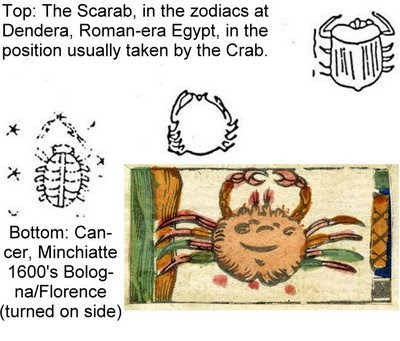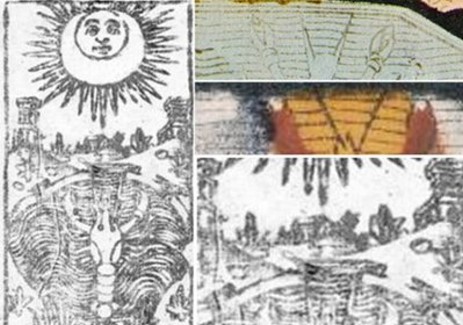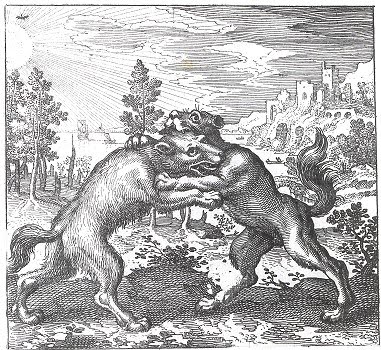I'd like to get back to the Cary Sheet Moon card--and, eventually, the dog and the wolf. The Cary Sheet Moon card is one of the cards on that sheet in which I see Egyptianate imagery, by which I mean images created during the Renaissance in response to a relatively new demand for Egyptian symbolism.
Does anyone else see two crocodiles sitting next to the lake, from the center of the bank to our right? They are sometimes identified as dogs. But if so, they are the strangest looking dogs I've ever seen. Above, I've enlarged where they are, on the right lower side of my image. They are facing each other, and the one on the right has something small and round in his jaws. I can't tell if the other one has anything or not.
Above the detail with the crocodiles, I've put the claws of the crayfish on the Noblet. If you notice the wavy lines indicating water, you will also notice that there are none in the open space between the pincers of the two largest claws. In the Conver, above the Noblet, there is actually something being held in both, roughly diamond-shaped. If you can't see these objects in the Conver, let me know and I will post the Camoin-Jodorowsky Moon, where they are more obvious.
In the Noblet and Conver, the crayfish, which has nothing in its mouth in the Cary Sheet, has taken over the job formerly done by the crocodiles, that of holding the precious little objects, like diamonds, glistening in the deep. It is the motif of the dragon with the treasure, or the Acts of Thomas' "one pearl,/which is in the middle of the sea/surrounded by the hissing serpent" (
http://en.wikipedia.org/wiki/Hymn_of_the_Pearl). The sea is not named, but it is in the vicinity of Egypt.
A few other aspects of the Cary Sheet Moon card look to me Egyptianate. Artificial pools were characteristic of temples; in Italy, there was the example of Trajan's Villa in Tivoli, always a great tourist spot, modeled on what Trajan saw in Egypt. In the background on the card are what might be a Greco-Egyptian temple, Parthenon-ish, and two obelisks (I'm not sure what the giant leaves are at their base), quintessentially Egyptian, as anyone in 15th century Rome would know.
When the crocodiles were later (see below) changed to dogs, or a dog and a wolf, that too is Egyptianate. Clement of Alexandria said:
The idea is that if the sun went any further north in its mid-day course than the Tropic of Cancer, it would make the summer too hot. And if it went any further south than the tropic of Capricorn, the winters would be too cold. Since the sun and the moon take the same course, they serve to guard the courses of both. (And it is possible that both are on this card, in a solar eclipse, during which dogs typically bark.) I get this reference from de Gebelin, always an interesting source of scholarly analysis of the cards (
http://www.tarotpedia.com/wiki/Du_Jeu_D ... I.The_Moon).
If they are not two dogs, but rather a dog and the wolf, from alchemy, that again is Egyptianate, for in the Renaissance Egypt was considered the home of alchemy. What we have, as suggested at the beginning of this thread, is the solar canine of the day and the lunar canine of the night, with the symbolism attaching to the Latin expression "between the wolf and the dog" (as well as to the two colors generally, in this card as elsewhere in the deck). It the same symbolism as the obelisks. Obelisks, as the highest structures, caught the first light of the sun. We are in the time between night and day.
The "Marseille" cards also have what look like drops--some say rays--coming down from the moon. De Geblin says:
Pausanias teaches us in his description of Phocide, that according to the Egyptians, it was the Tears of Isis that flooded each year the waters of the Nile & which thus rendered fertile the lands of Egypt. The tales of this Country also speak about a drop or tear, which falls from the Moon at the time when the waters of the Nile must swell.
Pausanias does indeed speak about the Egyptians' belief that the Nile flood was caused by the "tears of Isis" (
Description of Greece 10.32.18, at
http://www.theoi.com/Text/Pausanias10C.html).
Pausanias does not speak of the moon, but Plutarch talks of Isis as the moon (Isis and Osiris LI)--and Apuleius associates her with the moon in Lucius's famous night-time vision of Isis in his Golden Ass.
In this connection, Pausanias does not also speak of the "tears of Osiris" in the Sun card. But Plutarch does speak of Osiris as the water swelling in the flood, and Isis the fecundated earth (Isis and Osiris XXXIII-XXXIX). To be sure, the "drops" on the cards could be explained away as moonbeams and sunbeams. But they look like drops.
I have not found a reference to the two towers among Greco-Roman descriptions of Egypt, but that may be just me. De Gebelin says (http://www.tarotpedia.com/wiki/Du_Jeu_Des_Tarots):
This is similar to the function of the dogs, as de Gebelin says; but I do not see Clement of Alexandria mentioning the Pillars of Hercules It would make sense for them serve to guard against the Sun and Moon going to far one way or the other, after Phaeton's disaster, just like the dogs, but I can't find a specific reference.
De Gebelin also speaks of "two palaces" with guard-dogs. I cannot identify a source for this remark. Earlier, discussing the Maison-Dieu card, he spoke of two statues placed near each other, to winter and summer. That one I found, in his History. Herodotus (http://www.piney.com/Heredotus2.html) speaks of a certain temple complex, including:
Winter and summer do correspond to the sun's movement toward the two Tropics. And the two towers do stand at the gateway to a temple complex in the distance. True, the towers on the card are not statues, nor are there suggestions of offerings. The card-designer has made them into guardhouses. (As such, I have another interpretation of them from a Greco-Roman source, but since it is not Egyptianate I will discuss it in another post.)
I have not found any Greco-Roman source for Egyptian crayfish or lobsters. But again there is an Egyptianate interpretation for those who wanted one. The Latin "cancer" meant both crayfish and crab (http://freepages.rootsweb.ancestry.com/ ... ateng.html,
([url]http://en.wikipedia.org/wiki/Cancer_(constellation)), and the Greek "karabos" meant both "crab" and "beetle" (
http://www.wordinfo.info/words/index/in ... unit/3559/). Beetles are Egyptian, specifically the scarab beetle known--like the crab--for moving backwards. Plutarch
Isis and Osiris LXXIV (
http://thriceholy.net/Texts/Isis.html) compares it to the sun, which moves opposite to the apparent direction of the stars. Plutarch also describes it as depositing its semen in its dung and rolling it into a ball: this description does not fit a crayfish. But the crayfish is the scarab's northern relative, with common symbolism.
On the one hand, the crayfish is a symbol of rebirth, for like the snake it sheds its outer covering periodically, after which follows a period of extreme vulnerability. There is a persistent belief that molting occurs more often at the full moon. (See, among others,
http://docs.google.com/viewer?a=v&q=cac ... ccvJG5AVZw. Find "full moon." Flornoy reports his own observations of crayfish, apparently confirming this belief, in his book
Pelerinage des Bateleur.)
The scarab symbolizes rebirth by its ball of dung, containing its own progeny. Italians would have had the symbolism of rebirth confirmed by the scarab amulets found in Etruscan tombs (
1910 Encyclopedia Britannica: article on the scarab by Hugh Chisolm, in Google Books).
On the other hand, the crayfish is the sign of the zodiac corresponding to the moon and also to the first month of the Egyptian calendar. when the inundation of the Nile started, as de Gebelin points out--when the "tears of Isis" reached Egypt. The Dendera zodiac associated not only the crab but the scarab to that time, if we may speculate--here as with several other cards--that by the time of the Cary Sheet images from Dendera had reached Italy (drawings from Desroches-Noblecourt, [/i]Fabuleux Heritage de l'Egypte[/i]).

All in all, the saying "between the dog and the wolf" is reflected in more than just the two animals. July is the time between the dry season and the Nile flood, the pre-dawn of the annual cycle where the first signs appear. The scarab/crayfish's ball is the outward manifestation of new birth. And the crocodile holds in its jaw, or the crayfish its claw, the sun's brilliance itself, still hidden from casual view. (But shown more clearly below, Emblem XLVII of Michael Maier's
Atalanta Fugiens, 1618.)




